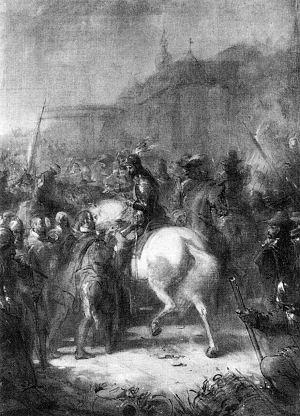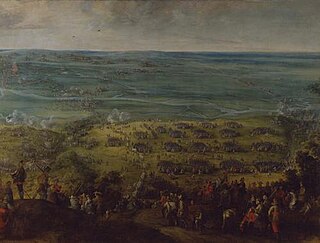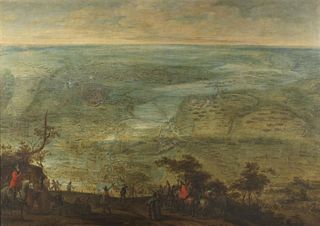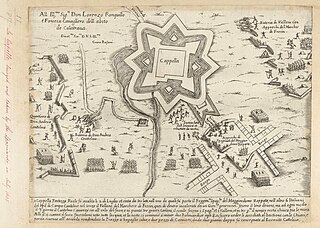
The Battle of Nördlingen took place on 6 September 1634 during the Thirty Years' War. A combined Imperial-Spanish force inflicted a crushing defeat on the Swedish-German army.

Cardinal-Infante Ferdinand was a Spanish and Portuguese prince, Governor of the Spanish Netherlands, Cardinal of the Holy Catholic Church, Archduke of Austria, Archbishop of Toledo (1619–41), and a general during the Thirty Years' War, the Eighty Years' War, and the Franco-Spanish War. He is commonly considered the last great commander and strategist of the Spanish Empire, whose premature death in a critical moment helped bring about the end of Spanish hegemony in Europe. He is, as well, one of few generals undefeated on the battlefield.

The Franco-Spanish War was fought from 1635 to 1659 between France and Spain, each supported by various allies at different points. The first phase, beginning in May 1635 and ending with the 1648 Peace of Westphalia, is considered a related conflict of the Thirty Years' War. The second phase continued until 1659, when France and Spain agreed to peace terms in the Treaty of the Pyrenees.

The Battle of Kallo was a major field battle fought from 20 to 21 June 1638 in and around the forts of Kallo and Verrebroek, located on the left bank of the Scheldt river, near Antwerp, during the second phase of the Eighty Years' War. Following the symbolic recovery of Breda during the 1637 campaign, the Dutch Republic agreed with the French Crown, with whom it had allied in 1635, to besiege a major city in the Spanish Netherlands during the 1638 campaign. The commander of the Dutch States Army, Frederick Henry of Orange, planned an approach over Antwerp from the two sides of the Scheldt. Count William of Nassau-Siegen was entrusted to land in the Spanish-controlled Waasland region, west of Antwerp, to seize the forts of Kallo and Verrebroek, along with several other key fortifications, to invest Antwerp from the west. In the meantime, Frederick Henry would advance on the opposite bank to complete the blockade of the city while the armies of France invaded the Spanish Netherlands from the south to oblige the Spanish Army of Flanders to divide its forces.

The siege of Schenkenschans was a major siege of the Eighty Years' War. In a successful campaign the Army of Flanders, commanded by Spanish general Cardinal-Infante Ferdinand of Austria, captured Schenkenschans along with a number of important towns, reversing recent Dutch gains and opening the Dutch Republic to a possible invasion. The Dutch Stadtholder, Fredrick Henry, pushed the republic's military efforts to their limit to recapture the fortress of Schenkenschans to counter the threat to the exposed Dutch heartland. He succeeded in doing so after a costly nine month siege.

The fourth siege of Breda was an important siege in the Eighty Years' War in which stadtholder Frederick Henry, Prince of Orange retook the city of Breda, which had last changed hands in 1625 when the Spanish general Ambrogio Spinola conquered it for the Spanish Habsburgs. Hereafter, the city would remain in the hands of the Dutch Republic until the end of the war.

The Battle of Les Avins took place on 20 May 1635, outside the town of Les Avins, near Huy in modern Belgium, then part of the Bishopric of Liège. It was the first major engagement of the 1635 to 1659 Franco-Spanish War, a connected conflict of the Thirty Years' War.

The siege of Leuven was an important siege in the Thirty Years' War in which a Franco-Dutch army under Frederick Henry of Orange and the French Marshals Urbain de Maillé-Brezé and Gaspard III de Coligny, who had invaded the Spanish Netherlands from two sides, laid siege to the city of Leuven, defended by a force of 4,000 comprising local citizen and student militias with Walloons, Germans, Spanish and Irish of the Army of Flanders under Anthonie Schetz, Baron of Grobbendonck. Poor organization and logistics and the spread of sickness among the French, along with the appearance of an Imperial-Spanish relief army of 11,000 under Cardinal-Infante Ferdinand and Ottavio Piccolomini, forced the invading army to lift the siege. This failure allowed the Spanish forces to take the initiative and soon the invaders were forced into a headlong retreat.

The Crossing of the Somme took place on 5 August 1636 during the Thirty Years' War and the Franco-Spanish War when units of the Spanish Army of Flanders and the Imperial Army under Thomas Francis, Prince of Carignano, lieutenant of the Cardinal-Infante Ferdinand of Austria, crossed the Somme river near Bray-sur-Somme during its offensive in French territory. Despite the fierce resistance of the French army led by Louis de Bourbon, Count of Soissons, the allied troops successfully crossed the river and drove off the French troops along the Oise river, proceeding over the following weeks to invest the important fortress of Corbie, located two leagues upriver of Amiens, which caused a spread of panic among the population of Paris.

The siege of Jülich was a major operation in the second phase of the Eighty Years' War that took place from 5 September 1621 to 3 February 1622. A few months after the Twelve Years' Truce between the Dutch Republic and the Spanish Monarchy expired, the Spanish Army of Flanders, led by the Genoese nobleman Ambrogio Spinola, went on the offensive against the Republic and approached the Rhine river to mask its true intentions: laying siege to the town of Jülich, which the Dutch States Army had occupied in 1610 during the War of the Jülich Succession. Although the capture of the town would not allow for a Spanish invasion of the Republic, its location between the Rhine and Meuse rivers rendered it strategically significant for both sides, given that the United Provinces greatly benefited from the river trade with the neighboring neutral states and Spain was pursuing a strategy of blockading the waterways which flowed across the Republic to ruin its economy.

The siege of Saint-Omer was a siege in the Thirty Years' War in which a French army under Gaspard III de Coligny, Maréchal de Châtillon, laid siege to the Flemish city of Saint-Omer, defended by a small garrison in command of Lancelot II Schetz, count of Grobbendonck. Despite several initial successes in the capture of the minor forts around Saint-Omer, on the night of 8/9 June a Spanish relief army under Thomas Francis, Prince of Carignano, surprised Châtillon's troops and established a small fort in the middle of the French lines. An entire army corps under Maréchal de La Force was ordered to move towards Saint-Omer to support Châtillon siege, but on 12 July a further Imperial-Spanish force commanded by Ottavio Piccolomini entered Saint-Omer, resolving the French marshals to withdraw.

The siege of Venlo was an important siege in the Eighty Years' War that lasted from 20 to 25 August 1637. The Cardinal-Infante Ferdinand of Austria, Governor of the Spanish Netherlands, retook the city of Venlo from the United Provinces, which had taken control of it in 1632 during the offensive of Frederick Henry, Prince of Orange against Maastricht. The capture of Venlo and Roermond, which was surrendered to the Cardinal-Infante a week later, effectively cut Maastricht from the Dutch Republic, thus preventing further attacks on the Spanish Netherlands from the east. In the southern front Ferdinand lost the towns of La Capelle, Landrecies, and Damvillers to the French, but then he forced them to retreat south of Maubeuge.

The siege of Schenkenschans was a siege that took place from 28 April to 2 May 1599 as part of the Eighty Years' War and the Anglo–Spanish War. Schenkenschans was garrisoned largely by English troops and was besieged by a Spanish force led by Francisco de Mendoza. The siege failed with losses and the Spanish were forced to retreat when a relief force arrived.
Events in the year 1635 in the Spanish Netherlands and Prince-bishopric of Liège.
Events in the year 1636 in the Spanish Netherlands and Prince-bishopric of Liège.

Guillaume III de Lamboy de Dessener, 1590 to 1659, was a Field Marshal in the Imperial Army, who served in the 1618 to 1648 Thirty Years War, and the 1635 to 1659 Franco-Spanish War.

The years 1621–1648 constituted the final phase of the Eighty Years' War between the Spanish Empire and the emerging Dutch Republic. It began when the Twelve Years' Truce (1609–1621) expired, and concluded with the Peace of Münster in 1648.

The Siege of La Capelle took place from the 2nd to the 8th of July in 1636 during the Franco-Spanish War (1635–1659) in which a Spanish army under Cardinal-Infante Ferdinand managed to seize the fortress of La Capelle from the French army retreating from a previous defeat taking place at Leuven.
The Siege of Le Catelet (1636) is a siege that took place from July 2 to the 5th of July. A Spanish army led by Cardinal-Infante Ferdinand would capture the fortress in only three days, the fastest siege within the 1636 campaign. This siege is a leadup to the Crossing of the Somme campaign led by Cardinal-Infante Ferdinand and his Imperial allies.

The First Siege of Corbie took place from the 7th to the 15th of August, 1636 during the Thirty Years' War and the Franco-Spanish War (1635–59) where a Spanish army under Cardinal-Infante Ferdinand and his lieutenant Prince of Carignano successfully capture the important French fortress of Corbie. The siege would only last a little over a week with the fortress eventually surrendering after 8 days on the 15th of August. This important siege battle is part of the Crossing of the Somme campaign led by the Cardinal-Infante and caused an important event to happen after the siege with the French royal family fleeing Paris in fear of the Spanish tercios and the Cardinal-Infante's campaign, which was thought to have been aimed towards the French capital.
















